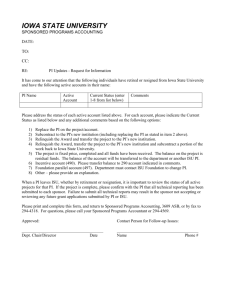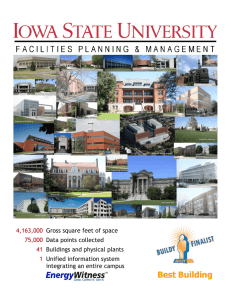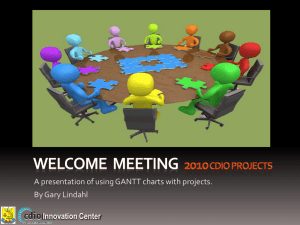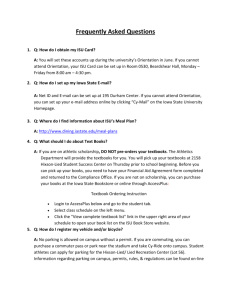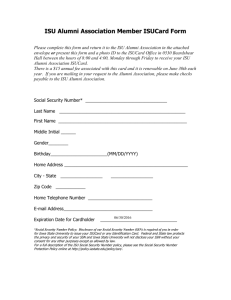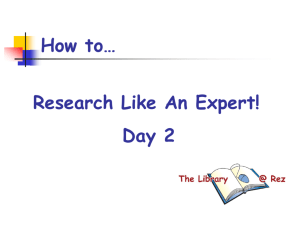Iowa State University Learning Communities: 50000 Success Stories
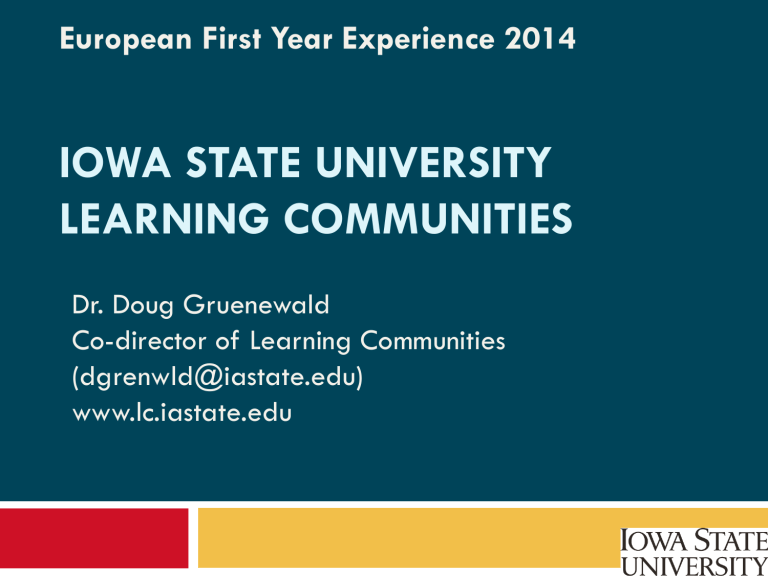
European First Year Experience 2014
IOWA STATE UNIVERSITY
LEARNING COMMUNITIES
Dr. Doug Gruenewald
Co-director of Learning Communities
(dgrenwld@iastate.edu) www.lc.iastate.edu
Iowa State University
Land Grant Research University
Located in Ames, Iowa, U.S. (pop: 60,000)
33,000 students (includes 4700 graduate students)
80% white , 12% non-white, 8% international
24.9
mean ACT score
90% of first year students live in residence halls
6 Colleges (Engineering, Liberal Arts, Agriculture)
100 majors
Learning Communities History
1995: 407 students, 12 LCs, volunteers
1998-2001: $1.5 M to expand program, develop structure
2002: 2,100 students in 46 LCs
2013: 5400 students in 80 LCs
1995-2014: 50,000 students served
Learning Communities Organization
Academic Affairs
Associate Provost for Academic Programs
Co-Director of Learning Communities
Center for Excellence in Learning & Teaching
Ann Marie VanDerZanden
Student Affairs
Associate Vice President for Student Affairs
Co-Director of Learning Communities
Doug Gruenewald
Program Coordinator
Learning Community Advisory Committee
College
Coordinator
Committee
LC Coordinators
(One or more for each LC)
Curriculum
Committee
Peer Mentors
(500+)
Peer Mentor
Committee
Strengths
Committee
Learning Community Goals
Develop sense of belonging
Make academic connections, enrich learning
Achieve learning outcomes of departments and programs
Improve retention and graduation rates
Improve student satisfaction
Increase interactions among students, faculty, and staff
Typical ISU Learning Community
Two or three courses in common
Usually organized by academic advisor
Peer mentors (upper-division students)
Career exploration
Service learning /community service
Social & co-curricular activities
Typical ISU Learning Community
Faculty &
Staff
Common
Courses
Peer
Mentor
Community
Service
Servicelearning
Student
Cocurricular
Activities
Career
Exploration
Social
Activities
Typical ISU Learning Community
Discipline-based
Primarily first year students
(20% upper-division students)
Average size: 30 – 40 students
(range from 12 – 200)
25% have residence cluster
Percent of First Years in LCs
80%
70%
60%
50%
40%
30%
20%
35%
2000
51%
2005
70%
2013
Total LC Students
6000
5000
4000
3000
2000
1000
0
407
1995
1838
2000
2468
2005
4198
2010
5400
2013
Variety of LCs
Entrepreneurship (coffee shop)
Design (art field trips)
B iology E ducation S uccess T eams
(Skunk River Navy service learning)
Ag BioSystems Engr (Fr.,So.,Jr.)
Retention and Graduation Rates
Data since 1998:
Average 1 year retention is 8% higher for LC students than non-LC students
Average 6 year retention/graduation is 11% higher for LC students than non-LC students
The program yields over $5 million per year
Learning Community Students
Report greater satisfaction with overall quality of instruction and overall experience at Iowa State
Report more knowledge of university services , their discipline , and career options
Report higher levels of student engagement and more positive perceptions of campus environment
(National Study on Student Engagement)
Learning Community Scholarship
Iowa State faculty and staff have published more than 50 articles and chapters and made over 140 professional conference presentations
19 theses and dissertations on learning communities have originated at Iowa State.
Faculty Comments
Dr. Steve Mickelson, Professor of Agricultural and
Biosystems Engineering (at ISU since 1982)
“The learning communities initiative at ISU is, in my opinion, the most meaningful student success program ever developed.”
Dr. Gail Nonnecke, Morrill Professor of Horticulture
(at ISU since 1987)
"Learning Communities continually enhance my teaching
- they engage and connect me with our students.”
Peer Mentors
“The student’s peer group is the single most potent source of influence on growth and development during the undergraduate years.”
Alexander Astin, “What Matters in College:
Four Critical Years Revisited”
Student Comments
“In the Design Exchange Learning Community I made many strong ties with student partners and future professors . By forming these relationships early, I have been able to benefit from their knowledge and experience. As a peer mentor , I will now be in more of a teaching role and will share and help these students with my experience.”
Architecture student
Student Comments
“When I came to school, I was entirely alone . I knew absolutely no one. Once I started getting involved with the learning community I felt more at home and happy with my surroundings because I had friends in my major , not only students, but teachers as well . I felt like I could ask questions and discover my true self .”
Vocal Music Education Student
Lessons Learned
Consider organizational structure : one or two people responsible (and with authority ) to keep things focused
Define a clear vision, purpose, outcomes
Use peer mentors
Assess what you do
More Lessons Learned
Include students whenever possible
Plan for continuity of program
Communicate share your story
Rewards, recognition, and fun
Future Directions
Increase involvement for transfer students, sophomores, and underrepresented groups
Continue to develop learning communities for all interested students
Questions?
